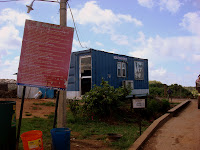The
second day of the clerkship programme dawned, with a promise of a “garbage dump
visit” looming upon us.. (What a treat!)
We were
taken to the Karadiyana Waste management project, which was just a few minutes’
drive from the MOH office in Werahera. Naturally, we were expecting the stench to hit
our nostrils the moment we neared the premises, but miraculously the smell was
quite bearable, however the sweltering heat was NOT!
The view comprised nothing but mountains of garbage, flocks of birds, some stray dogs & garbage trucks arriving every five minutes or so.
The view comprised nothing but mountains of garbage, flocks of birds, some stray dogs & garbage trucks arriving every five minutes or so.
Initially
the trucks were weighed. Just simple mathematics comes into play when these
trucks are weighed at the weighbridge with & without the load of garbage.
This helps in calculating the daily incoming waste tonnage. Accordingly we were
told that the average waste dumping in 2011 was about MT 326.96! (and this was
ONLY from the municipal councils of the vicinity!)
 |
| weighing at the weigh-bay |
 |
| The ideal truck for waste dumping |
We
learned how the garbage is dumped in “cell system” in order to diminish the
stench. Here the new garbage is covered with old garbage in a rotational basis,
since with time the odor from the decomposing material becomes less.
The area
is quite high in the scale of biodiversity. There were birds like crows, Egrets,
Brahminy kites; eating up maggots. We were told that they were hoping to
promote bird watching alongside those marshy lands aswel.
However
much good the dump does as a whole to the environment, there were quite a few
problems which were challenging the project.
The use
of the marshy land instead of a bare land has led to the leakage of pollutants
to the water stream leading to ground water contamination, residual soil
contamination and offgassing of methane generated by decaying organic material.
We were
also told that if this dumping continues the entire dump would be filled within
another year or two.
Therefore
steps have been taken to implement proposals put forward to open up a composed
plant as well as a power plant. Operations are due to commence in 2014.
Also the
need has arisen for the sterilization of the stray dogs in the area which
apparently poses a threat due to the spread of rabies
 |
| Stray dogs |
 |
| Varieties of birds |
Another
shocking, revelation was made when we were told about the average income of the
“ramp diggers”- the people who dig out the trash, hence sorting out the
plastic, metal & the recyclables. The recyclables are sold to the highest
bidder while 85% of the price goes to them & the rest into their welfare
fund.
The average
monthly salary of them was around 30,000-40,000/= !! The impact of those
words on us was clearly fascinating! There were quite a few of my group mates
who were definitely talking about “part time” jobs here!
Upon inquiry
we were told about how the health & welfare of these workers are
maintained. They are given boots, gloves, T shirts, Bottoms free of charge,
every 6 months. They are also screened for TB & Filariasis, blood works are
done to check on their blood sugar levels & cholesterol levels every 6
months. They are also vaccinated for tetanus & typhoid.
 At the end, we left the place with many
thoughts lingering on our minds. It was certainly an eye opener to us, as I’m
sure this visit was a first to all 38 of us. It left us thinking, yes we do borrow
earth from our children, but are we capable of returning it back just as it
was?
At the end, we left the place with many
thoughts lingering on our minds. It was certainly an eye opener to us, as I’m
sure this visit was a first to all 38 of us. It left us thinking, yes we do borrow
earth from our children, but are we capable of returning it back just as it
was?
-Dinithi Herath-
20/08/2012
Post- 01
No comments:
Post a Comment